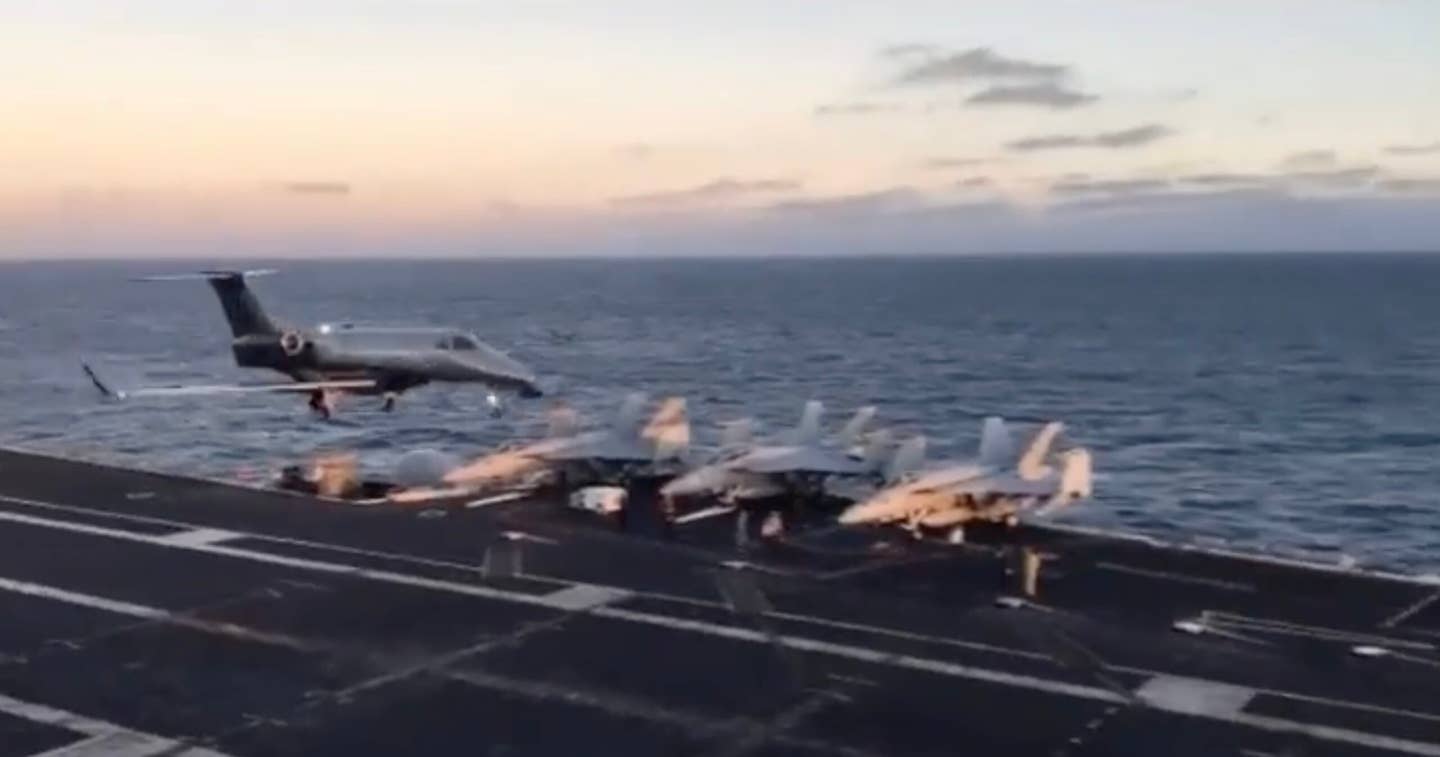As the Top Gun: Maverick movie continues to ‘roar & soar’ at the box office, a footage has emerged offering a glimpse of how some of the breathtaking aerial stunts were shot in the action-packed film.
Mission 2027 – Chinese Military Will Be ‘Ready For Action’ Against Taiwan & Allies In 5 Years – Defense Ministry
Recently, Eurasian Times reported how the US Navy’s latest and most advanced variant of its carrier-based E-2 Hawkeye airborne warning and control system (AWACS) aircraft made a cameo in the movie, marking a huge leap from its 1986 prequel.
Last week, Kevin LaRosa II, Top-Gun: Maverick’s aerial coordinator, shared sensational footage of an Embraer Phenom private jet flying just over the US Navy supercarrier USS Theodore Roosevelt (CVN-71).
The full video, originally posted on Instagram, provided a behind-the-scenes view of how some of the aerial shots around the aircraft carrier were filmed.
‘Tail Up & Nose Down’ – Why World’s Best Selling Fighter Jets Are Crashing In A Very Predictable Manner?
The footage from a hand-held camera inside the cockpit of an Embracer Phenom 300E light jet showcases a pilot’s view of how the scenes of aircraft approaching and buzzing over the aircraft carrier might have been captured for the movie.
While landing a fighter jet on an aircraft carrier is a highly complex task, the Phenom comes remarkably close to doing that by flying just a little low on glideslope as it crossed the fantail of the ship prior to powering up and going around.
The shot of the Phenom from the aircraft carrier, blasting over the landing area above a trio of F-18 Super Hornets, is phenomenal. It is nothing like anything seen before.

The little Phenom makes another pass that appears to be even better. It provides a viewpoint of a fighter pilot while approaching his jet to the aircraft carrier and sideways when the jet is on the carrier.
The Phenom 300E Camera Jet
The Phenom 300E was used for filming longer scenes, especially the ones over water, because of the aircraft’s larger fuel capacity and ability to fly for a longer duration.
“I flew the Phenom extensively on the movie and the platform excelled when we needed extended time on station or the reliability and added safety of two engines for over-water operations,” LaRosa posted on Instagram.
“It also gave us longer sortie times. The Phenom carried more fuel and was able to stay on station longer,” he said elsewhere.
The Phenom carried two SHOTOVER F1 RUSH gimbals, supplied by Team5 Aerial Systems, a global provider of aerial camera systems. One of the gimbals was mounted on the nose, while the other one was on the tail. Each camera was fitted with a different lens, one wide-angle and one very long lens.
“It [the aircraft] was also unique in that the Phenom carried two F1 camera gimbals from @team5aerials, allowing us to fly two entirely different lens options on the same flight.”
The back of the aircraft was configured with two operating stations for David Nowell and Michael Fitzmaurice, the two aerial directors of photography for the movie, who were in charge of framing and composing the shots that we see in the movie.
All of the helicopter and jet aerials were shot by Nowell and FitzMaurice, flown in the L-39 Cinejet, an Embraer Phenom 300 camera jet, or an Airbus AStar/H125 helicopter.
“It’s my job to put the camera in the right spot, and it’s their job to compose the shot,” said LaRosa.
The Intense Dog Fighting Sequences
The L-39 Cinejet and the Airbus AStar/H125 helicopter were used for capturing dogfighting sequences.
Of these, the L-39 Cinejet was developed based on the airframe of Aero Vodochody L-39 Albatros. The Cinejet also carries a Shotover F1 Rush, which housed a Sony Venice camera with Fujinon lenses for the movie.
“It allowed me to maneuver that aircraft through canyons at high rates of speed, pulling up to 3Gs, without making our image shaky or unstable,” said LaRosa about the Cinejet.
The long nose and strong airframe of the L-39 allowed LaRosa to mount the camera a great distance forward of the wings which provided a good field of view.
“We can look beneath our jet, behind, above our wing, and behind us, before we see our own aircraft in the shot. This is something different and new that wasn’t possible before,” described LaRosa.
Meanwhile, the Airbus H125 AStar carried an Airfilm AF200 bracket holding a Shotover K1 camera gimbal capable of holding a larger camera body or a long lens to convey a sense of speed and agility by showing jets ripping past the lens.
That said, it is evident from the various behind-the-scenes footage that many technological advancements and crafty aviation have gone into the making of the many breathtaking aerial shots featured in the movie.
- Contact the author at tanmaykadam700@gmail.com
- Follow EurAsian Times on Google News